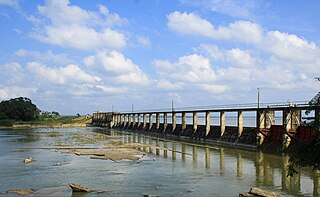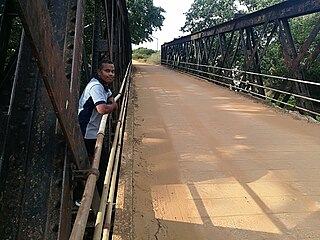Related Research Articles

Mullaitivu is the main town of Mullaitivu District, situated on the north-eastern coast of Northern Province, Sri Lanka. A largely fishing settlement, the town in the early twentieth century grew as an anchoring harbour of the small sailing vessels transporting goods between Colombo and Jaffna. The town has a District Secretary's office, many other government institutions and schools located in and around the area.
The Vanni, also spelled Wanni, is the name given to the mainland area of the Northern Province of Sri Lanka. It covers the entirety of Mannar, Mullaitivu and Vavuniya Districts, and most of Kilinochchi District. It has an area of approximately 7,650 square kilometres (2,950 sq mi). The population and infrastructure of the Vanni were devastated by the Sri Lankan Civil War.

Mullaitivu District is one of the 25 districts of Sri Lanka, the second level administrative division of the country. The district is administered by a District Secretariat headed by a District Secretary appointed by the central government of Sri Lanka. The capital of the district is the town of Mullaitivu.
Nai Aru Lagoon is an estuarine lagoon in Mullaitivu District, north-east Sri Lanka.
The Kanakarayan Aru is a river in Northern Province, Sri Lanka. The river rises in eastern Vavuniya District, near Omanthai, and flows north through Vavuniya District, Mullaitivu District and Kilinochchi District. It empties into the Chundikkulam Lagoon.

The Parangi Aru is a river in Northern Province, Sri Lanka. The river rises in central Vavuniya District, before flowing north/north-west through Vavuniya District, Mannar District and Mullaitivu District. The river empties into Palk Bay.

Pali Aru is a river in Northern Province, Sri Lanka. The river rises in northern Vavuniya District, near Puliyankulam, before flowing north/northwest through Vavuniya District, Mullaitivu District and Mannar District. The river empties into Palk Bay. The southern section of the river is sometimes known as Chamalankulam Aru.
The Nay Aru is a river in Northern Province, Sri Lanka. The river rises in south-west Vavuniya District, before flowing north/north-west through Vavuniya District and Mannar District. The river empties into Palk Bay.
The Per Aru is a river in Northern Province, Sri Lanka. The river rises in northern Vavuniya District, before flowing north/north-east through Vavuniya District and Mullaitivu District. The river empties into Nanthi Kadal lagoon.
The Mandekal Aru is a river in Northern Province, Sri Lanka. The river rises in the western Mullaitivu District, before flowing north through Mullaitivu District and Kilinochchi District. It empties into Palk Bay.
The Pallavarayankaddu Aru is a river in Northern Province, Sri Lanka. The river rises in western Mullaitivu District. It flows north-west through Mullaitivu District and Kilinochchi District, before emptying into Palk Bay.
The Akkarayan Aru is a river in Northern Province, Sri Lanka. The river rises in north-west Mullaitivu District. It flows north through Mullaitivu and Kilinochchi districts before emptying into Jaffna Lagoon.
The Netheli Aru is a river in Northern Province, Sri Lanka. The river rises in central Mullaitivu District, and flow north through Mullaitivu District and Kilinochchi District. The river empties into Chundikkulam Lagoon after a 24 km (15mi) journey.
Piramenthal is a small river in Northern Province, Sri Lanka. The river rises in northern Mullaitivu District, before flowing north through Mullaitivu District and Kilinochchi District. The river empties into Chundikkulam Lagoon.
Nay Aru is the name of two rivers in Northern Province, Sri Lanka:

The Nay Aru is a small river in Northern Province, Sri Lanka. The 20 km long river rises in south-east Mullaitivu District, before flowing north-east through Mullaitivu District. The river empties into Nai Aru Lagoon.
The Kodalikkallu Aru is a small river in Northern Province, Sri Lanka. The river rises in south-east Mullaitivu District, and flows in north/north-east through Mullaitivu district. The river empties into Nanthi Kadal lagoon.

The Northern Province is one of the nine provinces of Sri Lanka. The province has an area of 8,884 km2, making it the 3rd largest province by area, and a population of 1,061,315, making it the least populated province. The city of Jaffna is the capital city of the province.
Weli Oya,(Sinhala: වැලිඔය, romanized: Weli Oya) is a Sinhalese colony area in Mullaithivu District, Sri Lanka formerly known as Manal Aru. Weli Oya has been affected by the Sri Lankan civil war and government Sinhala colonization programs.

1984 Kokkilai massacres refers to a series of massacres of Sri Lankan Tamil civilians when the Sri Lankan military attacked the village of Kokkilai and several neighboring villages in Mullaitivu District, Northern Province, Sri Lanka. The attack left several civilians including women and children dead and their property destroyed. The attacks resulted in widespread displacement of native residents and subsequently their lands were colonized by Sinhala settlers.
References
- ↑ "Northern Province Statistical Information 2017" (PDF). Northern Provincial Council. 2017. p. 140. Retrieved 14 March 2018.